We are very pleased to announce the recent acquisition of the first comprehensive treatise ever published about the illustration technique of woodcut: Jean Michel Papillon. Traité historique et pratique de la Gravure en bois. 2 vols. (Pierre Guillaume Simon, 1766). Papillon’s manual is particularly remarkable for including a fully illustrated step-by-step depiction of the sixteenth-century technique of chiaroscuro.
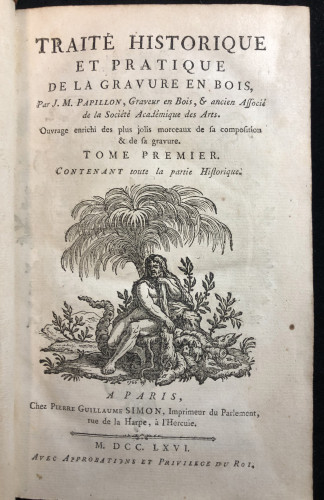
Jean Michel Papillon. Traité historique et pratique de la Gravure en bois. 2 vols. (Pierre Guillaume Simon, 1766)
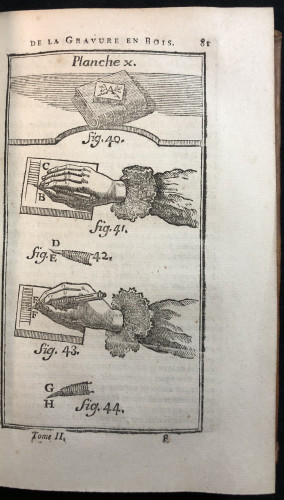
Woodcut showing basic techniques of carving the block, from Jean Michel Papillon. Traité historique et pratique de la Gravure en bois. 2 vols. (Pierre Guillaume Simon, 1766).
In 1516, the Italian artist Ugo da Carpi obtained from the Senate of Venice the first privilege (what today we would call “exclusive rights”) for the printing of color woodcuts by using a technique that he described as being his own invention: un modo nuovo di stampare chiaro et oscuro (a new technique for printing in dark and light). Essentially, this method was an attempt to depart from the obvious limitations of the black-and-white woodcut prints and, therefore, to produce effects that were more naturalistic by the application of color and tonality. It was also a commercial endeavor to take advantage of the increasing popularity of chiaroscuro drawings at that time. In brief, artists using this technique drew on colored paper (normally blue or brown) with pencil or pen, adding white gouache for the highlights to emphasize volume and tonality. In fact, Ugo da Carpi, for instance, created many chiaroscuro woodcuts based on chiaroscuro drawings by well-known artists such as Girolamo Francesco Maria Mazzola, also known as Parmigianino.
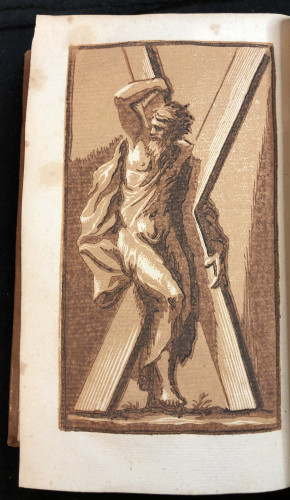
Example of a color woodcut made in the chiaroscuro technique, from Jean Michel Papillon. Traité historique et pratique de la Gravure en bois. 2 vols. (Pierre Guillaume Simon, 1766)
In a few words, the chiaroscuro woodcut technique consists of the use of interdependent blocks, that is, of a key-block (the one with the details of the design, often printed in black) and of one or more tone blocks in monochrome shades, all of them designed to produce a tonal image. Each of these blocks were then printed in the common press one after another, like jigsaw pieces gradually being fitted together to form a complete picture. Although Papillon talks about a strange contraption machine for the blocks, altogether unknown in the sixteenth century, and a roller press for their printing instead of the common press, he depicts the chiaroscuro technique accurately and with great visual detail. For his example of a four-block chiaroscuro woodcut, he uses the first block for the highlights displayed on a green background; the main outlines of the figure are in the second and third tone blocks; and, finally, the fourth block in thick black would print the darkest shadows.1
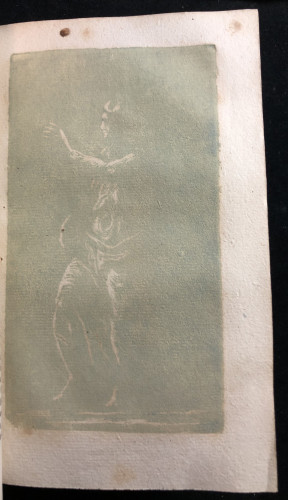
Woodcut impression of block one, from Jean Michel Papillon. Traité historique et pratique de la Gravure en bois. 2 vols. (Pierre Guillaume Simon, 1766)
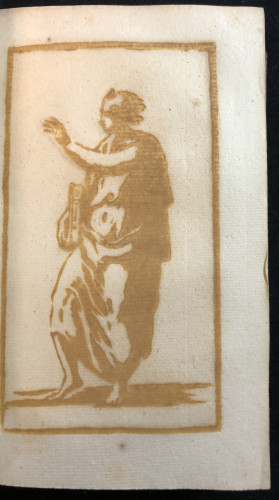
Woodccut impression of block two, from Jean Michel Papillon. Traité historique et pratique de la Gravure en bois. 2 vols. (Pierre Guillaume Simon, 1766)

Woodcut impression of block three, from Jean Michel Papillon. Traité historique et pratique de la Gravure en bois. 2 vols. (Pierre Guillaume Simon, 1766)

Woodcut impression of block four, from Jean Michel Papillon. Traité historique et pratique de la Gravure en bois. 2 vols. (Pierre Guillaume Simon, 1766)
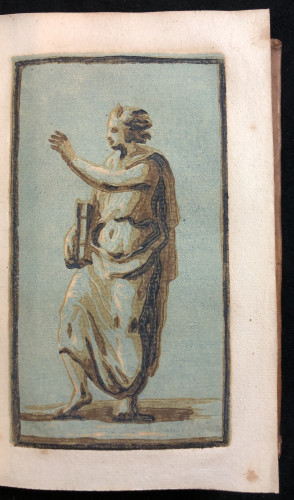
Color woodcut from four blocks, in the chiaroscuro technique, from Jean Michel Papillon. Traité historique et pratique de la Gravure en bois. 2 vols. (Pierre Guillaume Simon, 1766)
Unquestionably, this extraordiary manual will be very useful in various U of M courses and seminars, including the annual SCRC workshop on the identification of early illustration processes in books.
1. Elizabeth Savage. "Colour Printing in Relief c. 1700: A Technical History," in Printing Colour 1400-1700: History, Techniques, Functions and Receptions. Ed. Ad Stijnman and Elizabeth Savage (Leiden; Boston: Brill, 2015): 34. Naoko Takahatake. "The Italian Chiaroscuro Woodcut: History and Technique" in Naoko Takahatake. The Chiaroscuro Woodcut in Renaissance Italy, with contributions by Jonathan Bober, Jamie Gabbarelli, Antony Griffiths, Peter Parshall, and Linda Stiber Morenus (Los Angeles: Los Angeles County Museum of Art; Munich: DelMonico Books/Prestel, 2018): 12-13.